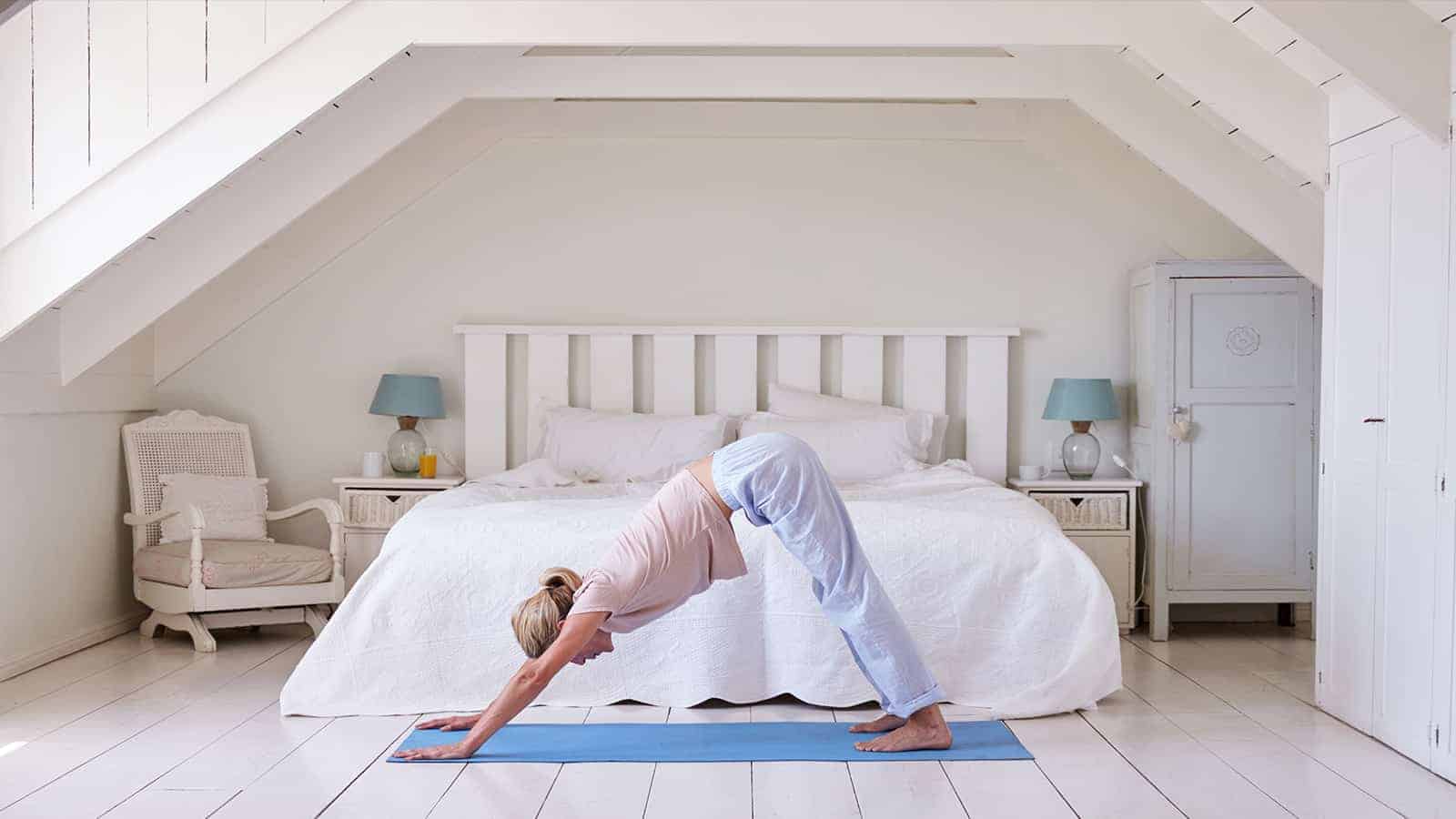Restorative yoga is a type of yoga practice designed to open your body with slow movements and deep breathing. While many contemporary yoga practices focus on speed of movement and tackling lots of different postures per session, restorative yoga does the opposite. Instead, you may only perform a couple of poses per session and hold them for much longer.
The goal is to sync up your mind, body, and breath through slow, passive stretching.
Restorative yoga (also called Yin Yoga) is a very different experience for people used to more active, athletic practices. If you’ve taken a yoga class recently, chances are it’s been of a more active variety designed to cycle quickly through poses. This type of yoga is great for building up strength and flexibility but does little in terms of relaxation.
The slow, deliberate movements of restoration yoga, on the other hand, are designed to aid your muscles in reaching full relaxation. This is why restorative practices use props so your body doesn’t need to support itself and you can allow your muscles to go limp.
Since Yin Yoga is so different from active practices, it’s a perfect complement to more strenuous forms of yoga. It’s also a great form of yoga for beginners!
Benefits of Restorative Yoga
As yoga has gained mainstream popularity, it’s also grabbed the attention of the scientific community. Health researchers have identified a number of ways that yoga benefits physical and emotional wellness, including:
- Stress management
- Improved mental and emotional health
- Promoting healthy eating habits and physical activity habits
- Better sleep
- Increased balance and flexibility
Scientific research has also shown that yoga can be used to improve specific conditions and ailments:
- Help manage symptoms of anxiety and depression
- Relief from low-back pain and neck pain
- Relief from menopause symptoms
- Manage symptoms of chronic diseases and improve the overall quality of life
- Help people manage weight
- Help people quit smoking
The Practice
At its very basic level, Yin yoga is the practice of holding a few poses for an extended period of time paired with deep, relaxed breathing. You’re encouraged to use props like yoga blocks to carry the weight of your body so your muscles can deeply relax instead of supporting the body’s weight.
Restorative yoga can be practiced independently or in tandem with active forms of yoga. Some students like to tack Yin Yoga onto the end of an active yoga session to cool down their muscles and breathing. Others practice restorative yoga all on its own to simply relax the body and mind. Yin Yoga is especially helpful when you’re feeling tired, burned out, or have too much energy.
Set an Intention
Before you lay down on your mat, think of why you’re settling in for a restoration yoga session.
When you set an intention, you’re focusing your awareness on a particular goal, virtue, or quality you want to enhance during the session.
In other words, what are you looking to accomplish? Do you want to simply relax and unwind after a tough day? Are you trying to manage symptoms of chronic disease? Whatever the reason is, determine your goal and remind yourself of it throughout your practice. For some, it may be something as simple as expressing gratitude, releasing negativity, or clearing your mind so you can start your day with a blank slate.
Breathing
Proper breathing is the key to getting the most out of Yin Yoga. During your session, you should maintain relaxed, deep, belly breathing. To get into the groove of belly breathing, place a hand on your stomach and feel the gentle rise and fall of your breath. If you ever “fall out” of your breathing routine, simply place your hand back on your belly until your respiration slows down and stabilizes.
Belly breathing forces you to slow down, promoting relaxation and mindfulness. Deep breathing increases the amount of oxygen in your bloodstream, which lowers your heart rate and blood pressure. Plus, by concentrating on your breath, you have less mental bandwidth to devote to stressing about your day or worrying about things you need to get done.
Warm-Up
Before diving into a restoration yoga session, we recommend warming up your muscles. Running through a few gentle poses will limber up your muscles so you can more easily hold restorative poses for an extended period of time. Plus, it will help shed some of your body’s extra energy and restlessness so you can more fully relax into each pose.
The Poses
In restorative yoga, each pose is held for an extended period of time. Unlike more athletic forms of yoga that focus on strength-building and flexibility, Yin Yoga doesn’t quickly cycle through many poses. Instead, you’ll hold each pose for anywhere from 5 minutes to 20 minutes.
The key to Yin Yoga is comfort. At no point should you be in discomfort or pain. Since the goal is to relax, your body also shouldn’t need to exert itself much to hold each pose. If a pose feels strenuous, you can place a block to support that part of your body and help take a load off your muscles. You should feel comfortable, relaxed, and at ease in each pose.
Here are some of the most popular yoga poses for restorative practice:
- Child’s pose (balasana
- Corpse pose (savasana)
- Side-lying corpse pose (side-lying savasana)
- Happy baby pose (ananda balasana)
- Legs-up-the-wall pose (viparita karani)
- Reclining bald eagle pose (supta baddha konasana)
- Adept’s pose (siddhasana)
- Legs-on-a-chair pose
Hint: Don’t Skip the Props!
Some yoga practitioners don’t like props, but we highly encourage using them to get the most out of your Yin Yoga session. When you forgo props, your muscles have to make up for that extra exertion. The more your muscles exert themselves, the less they can relax.
Remember: you are not looking to build up muscle strength with restorative yoga. That’s the realm of more active forms of yoga like ashtanga, bikram, and vinyasa flow.
When it comes to props, the sky is the limit! Use whatever helps you feel best supported. You can buy props specifically designed for yoga or you can get creative and use things from around your house. Popular props for restoration yoga include blocks, straps, rolled-up blankets or towels, balance balls, furniture like chairs and walls, sandbags, and pillows. Using a combination of props will help you support your body wherever it’s needed so you can sink into the deepest possible level of relaxation.
So, go ahead and raid your bed for pillows and blankets–your practice will benefit from it!
Tips for Amazing Yin Yoga Practice
1. Timing is key
Restoration yoga is all about slowing down and experiencing the moment. To get the most out of your practice, each yoga pose should be held between 5 to 20 minutes. How long your overall session runs depends on how many poses you want to do.
The long period of time in each position gives your body a chance to fully relax and literally “melt” into the pose. Of course, if you need to, you can always readjust or make small movements to keep your body comfortable throughout the pose.
2. Stay warm
When your muscles are warm, they’re more flexible and limber than when your body is cold. To help your body ease into each pose and comfortably remain there for a long period of time, be sure to keep your room warm and free of drafts. You can also dress in layers as long as it doesn’t limit your range of motion. Get comfy!
3. Put on music
The right kind of music can help you stay mentally grounded during your session. One common struggle people face is the mind-wandering that happens when you’re holding a single pose for up to twenty minutes at a time. Music–as long as it’s not distracting or disruptive–can help keep your mind on track and in a relaxed state.
4. Keep it simple
With the sheer number of yoga poses at your fingertips, it’s easy to get carried away and try to cram your session with tons of elaborate positions you saw on Instagram. For restorative sessions, simple is best! Stick with a couple of basic, comfortable poses. You’re encouraged to use props during restorative practice, but don’t get bogged down by equipment either–if you’re constantly moving blocks or rolling and re-rolling blankets, you’ll get flustered. Instead, just relax and go with the flow!
Final Thoughts on Restorative Yoga
Adding Yin Yoga to your practice is an excellent way to enhance your physical and emotional wellness routine. Restorative yoga is an effective method of dealing with unpleasant situations in life like burn out, stress, anxiety, and feelings of being overwhelmed by work or school. A restorative practice can also help you physically recover after a strenuous workout. With as many physical benefits as emotional, Yin Yoga is a perfection addition to anyone’s practice.
When you finish a restorative session, you will feel healthier, more rejuvenated, and better balanced. As much as our bodies benefit from rigorous physical activity, it equally benefits from slowing down and resting. And since Yin Yoga is such a gentle practice, people of all ages and levels of physical fitness can do it and feel good. Roll out your mat and get started!


















